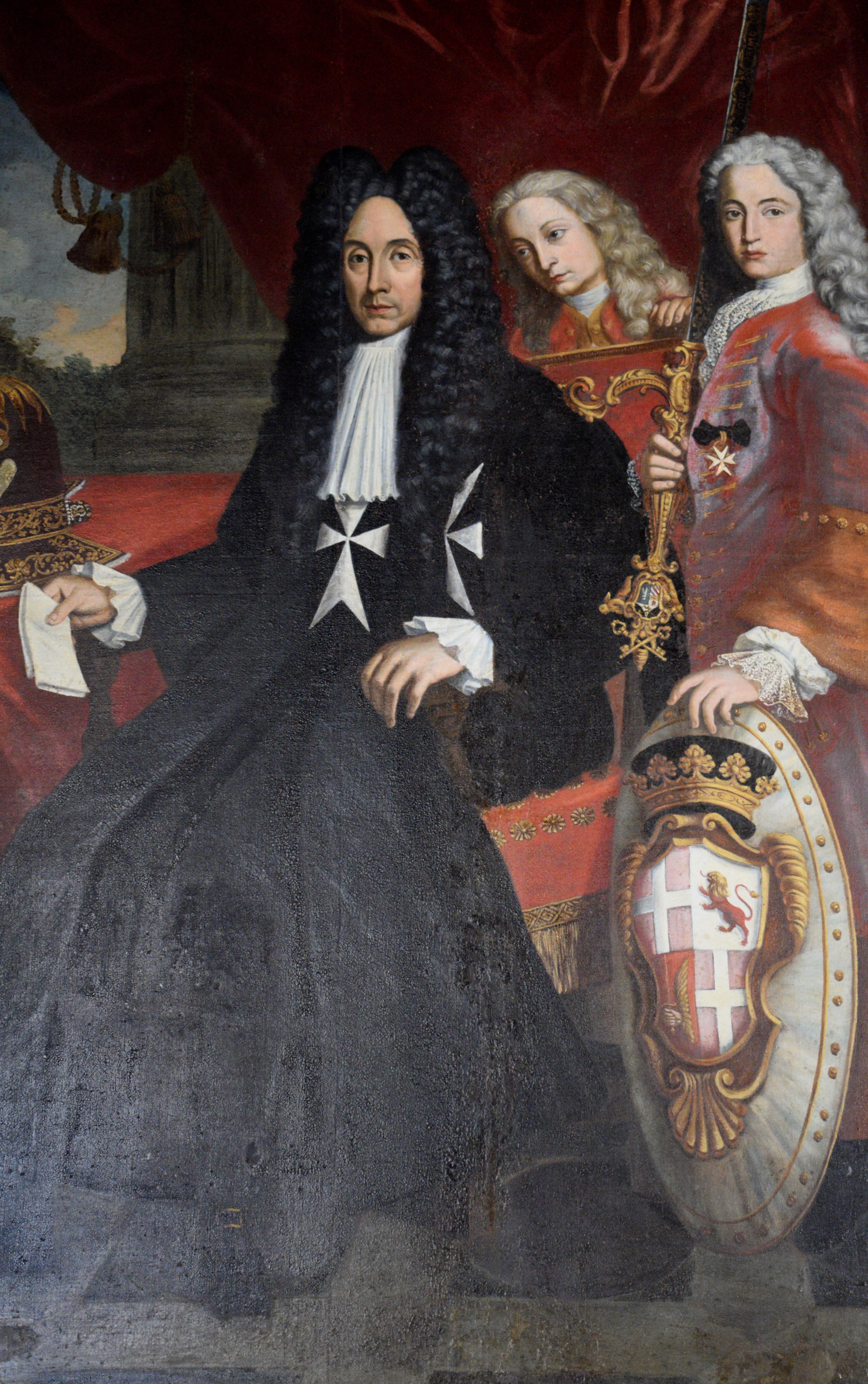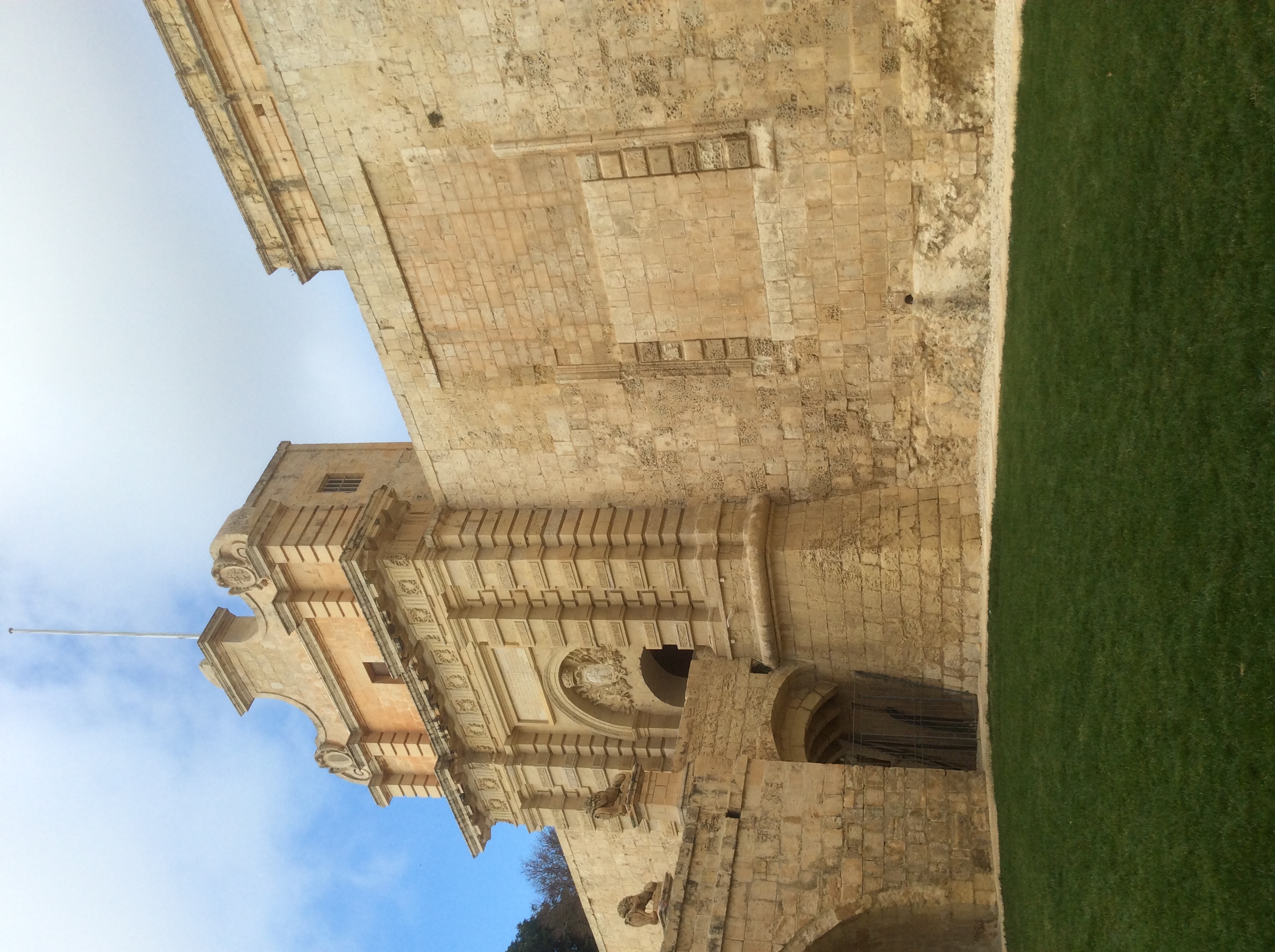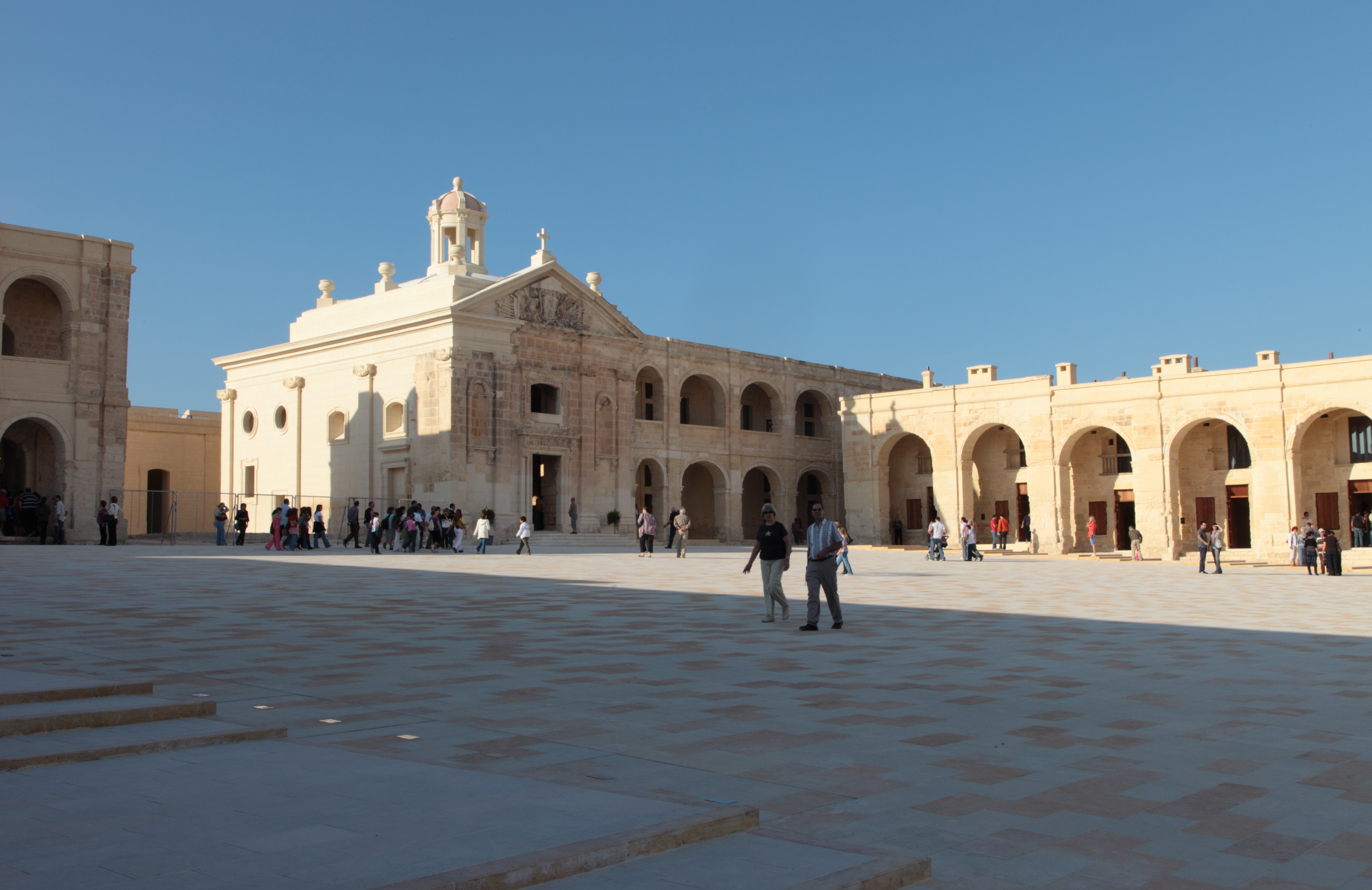|
António Manoel De Vilhena
António Manoel de Vilhena (28 May 1663 – 10 December 1736) was a Portuguese nobleman who was the 66th Prince and Grand Master of the Order of St. John of Jerusalem from 19 June 1722 to his death in 1736. Unlike a number of the other Grand Masters, he was benevolent and popular with the Maltese people. Vilhena is mostly remembered for the founding of Floriana, the construction of Fort Manoel and the Manoel Theatre, and the renovation of the city of Mdina. Early life António Manoel de Vilhena was born in Lisbon on 28 May 1663 to the aristocrat and general Dom Sancho Manoel de Vilhena, 1st Count de Vila Flor and his first wife, Ana de Noronha. His father fought in wars in central Europe, in Brazil against the Dutch, and in the Portuguese Restoration War against the Spanish Crown. Vilhena was also a remote descendant by one of his direct paternal branches of the noble and royal Castilian . He was a remote uncle of the Duke of Terceira. Magistracy De Vilhena was elected Gr ... [...More Info...] [...Related Items...] OR: [Wikipedia] [Google] [Baidu] |
List Of Grand Masters Of The Knights Hospitaller
This is a list of grand masters of the Knights Hospitaller, including its continuation as the Sovereign Military Order of Malta after 1798. It also includes unrecognized "anti-grand masters" and lieutenants or stewards during vacancies. In lists of the heads of the Order, the title "grand master" is often applied retrospectively to the early heads of the Order. The medieval heads of the Order used the title of ''custos'' (guardian) of the Muristan, hospital. The title ''magister'' (master) is used on coins minted in Rhodes, beginning with Foulques de Villaret. The first to use the title ''grandis magister'' (grand master) was Jean de Lastic (reigned 1437–1454). Later grand masters in Rhodes used ''magnus magister'' (grand master). In 1607 Holy Roman Emperor Rudolf II, Holy Roman Emperor, Rudolf II created the grand master a prince of the Holy Roman Empire (''Reichsfürst'').''Gothaisches Genealogisches Handbuch des Fürstlichen Häuser'', Fürstliche Häuser Band 2 (Marburg: V ... [...More Info...] [...Related Items...] OR: [Wikipedia] [Google] [Baidu] |
Crown Of Castile
The Crown of Castile was a medieval polity in the Iberian Peninsula that formed in 1230 as a result of the third and definitive union of the crowns and, some decades later, the parliaments of the kingdoms of Kingdom of Castile, Castile and Kingdom of León, León upon the accession of the then Castilian king, Ferdinand III of Castile, Ferdinand III, to the vacant List of Leonese monarchs, Leonese throne. It continued to exist as a separate entity after the personal union in 1469 of the crowns of Castile and Crown of Aragon, Aragon with the marriage of the Catholic Monarchs up to the promulgation of the Nueva Planta decrees by Philip V of Spain, Philip V in 1716. In 1492, the voyage of Christopher Columbus and the discovery of the Americas were major events in the history of Castile. The West Indies, Islands and Mainland of the Ocean Sea were also a part of the Crown of Castile when transformed from lordships to kingdoms of the heirs of Castile in 1506, with the Treaty of Villafá ... [...More Info...] [...Related Items...] OR: [Wikipedia] [Google] [Baidu] |
Marsamxett Harbour
Marsamxett Harbour (), historically also referred to as Marsamuscetto, is a natural harbour on the island of Malta. It is located to the north of the larger Grand Harbour. The harbour is generally more dedicated to leisure use than the Grand Harbour. Description The harbour mouth faces north east and is bounded to the north by Dragut Point and Tigné Point. Its northwest shore is made up of the towns of Sliema, Gżira and Ta' Xbiex. The harbour then extends inland to Pietà, Malta, Pietà and Msida. Off Gżira lies Manoel Island, now connected to the mainland by a bridge. The south eastern shore of the harbour is formed by the Sciberras peninsula, which is largely covered by the town of Floriana and the city of Valletta. At its tip lies the 16th century Fort Saint Elmo. The Sciberras peninsula divides Marsamxett from the larger parallel natural harbour, Grand Harbour. Along its partner the Grand Harbour, Marsamxett lies at the centre of gently rising ground. Development has gro ... [...More Info...] [...Related Items...] OR: [Wikipedia] [Google] [Baidu] |
Manoel Island
Manoel Island (), formerly known as Bishop's Island (, ) or the ''Isolotto'', is a small island which forms part of the municipality of Gżira in Marsamxett Harbour, Malta. It is named after the Portuguese Grand Master António Manoel de Vilhena, who built Fort Manoel, a fort on the island in the 1720s. The island was in turn renamed after the fort. Geography Manoel Island is a low, rather flat hill, shaped roughly like a leaf. It is located in the middle of Marsamxett Harbour, with Lazzaretto Creek to its south and Sliema Creek to its north. The island is connected to mainland Malta (island), Malta by a bridge. The whole island can be viewed from the bastions of the capital Valletta. History In 1570, the island was acquired by the Cathedral Chapter of Mdina and it became the property of the Roman Catholic Archdiocese of Malta#Bishops of Malta, Bishop of Malta. It was therefore called ''l'Isola del Vescovo'' or il-''Gżira tal-Isqof'' in Maltese (the Bishop's Island). In 1592 ... [...More Info...] [...Related Items...] OR: [Wikipedia] [Google] [Baidu] |
Malta 230915 Valletta 08
Malta, officially the Republic of Malta, is an island country in Southern Europe located in the Mediterranean Sea, between Sicily and North Africa. It consists of an archipelago south of Italy, east of Tunisia, and north of Libya. The two official languages are Maltese language, Maltese and English language, English. The country's capital is Valletta, which is the smallest capital city in the EU by both area and population. It was also the first World Heritage Site, World Heritage City in Europe to become a European Capital of Culture in 2018. With a population of about 542,000 over an area of , Malta is the world's List of countries and dependencies by area, tenth-smallest country by area and the List of countries and dependencies by population density, ninth-most densely populated. Various sources consider the country to consist of a single urban region, for which it is often described as a city-state. Malta has been inhabited since at least 6500 BC, during the Mesolith ... [...More Info...] [...Related Items...] OR: [Wikipedia] [Google] [Baidu] |
Corte Capitanale
The Corte Capitanale is a former courthouse in Mdina, Malta, which currently serves as a city hall. It was built in the Baroque architecture, Baroque style between 1726 and 1728, to designs of the French architect Charles François de Mondion. The building is linked to Palazzo Vilhena, but it has its own entrance and façade. History The Corte Capitanale was built between 1726 and 1728 along with the rest of Palazzo Vilhena, the List of Grand Masters of the Knights Hospitaller, Grand Master's official residence in Mdina. The building was mainly a courthouse, but it also served as the seat of the ''Capitano della Verga''. Its linking to the palace was a symbolic gesture to convey the fact that the courts were under the jurisdiction of the Knights Hospitaller, Order of St. John. The courthouse was also linked to the Bishop's Palace through a now-blocked underground passage, indicating the Church's role in the courts. During the French occupation of Malta, a Maltese doctor was acc ... [...More Info...] [...Related Items...] OR: [Wikipedia] [Google] [Baidu] |
Banca Giuratale (Mdina)
The Banca Giuratale (), also known as the Municipal Palace (), is a public building in Mdina, Malta. It was built in the 18th century to house the city's administrative council and courts, and was later used as a private residence and a school. It now houses part of the National Archives of Malta. History The site was originally occupied by the Archives Building of Mdina. The Banca Giuratale was built between 1726 and 1728 to house the Università, the civil administrative council of Mdina, after their original premises were taken over by Grand Master António Manoel de Vilhena in order to build Palazzo Vilhena. The new building was designed by Charles François de Mondion, a French architect who was responsible for rebuilding many buildings in Mdina. It also housed the district court. During the Maltese uprising against the French occupation of Malta, the Banca Giuratale was the meeting place of the National Assembly, which was set up by the Maltese to govern the island a ... [...More Info...] [...Related Items...] OR: [Wikipedia] [Google] [Baidu] |
Palazzo Vilhena
Vilhena Palace (; ), also known as the Magisterial Palace () and Palazzo Pretorio, is a French Baroque palace in Mdina, Malta. It is named after António Manoel de Vilhena, the Grand Master who commissioned it. It was built between 1726 and 1728 to designs of the French architect Charles François de Mondion, on the site of the meeting place of the Università. The palace was used a hospital in the 19th and 20th centuries, and it became known as Connaught Hospital after 1909. Since 1973, it has been open to the public as Malta's National Museum of Natural History. History Background and construction The site of Vilhena Palace has been inhabited since ancient times, and post-Punic remains have been found in the area. In around the 8th century, a Byzantine fort was probably built on the site, and in the Middle Ages it developed into a castle known as the ''Castellu di la Chitati''. The castle's inner walls were demolished in the 15th century, and the remaining part was built up ... [...More Info...] [...Related Items...] OR: [Wikipedia] [Google] [Baidu] |
Torre Dello Standardo
The ''Torre dello Standardo'' (, ) is a tower in Mdina, Malta, forming part of the city's fortifications. It was built by the Order of St. John between 1725 and 1726, on the site of an earlier tower, and its purpose was to communicate signals between Mdina and the rest of Malta. Today, the tower is in good condition, and it serves as a tourist information centre and for occasional cultural events. History Torre Mastra/de la Bandiera The Torre dello Standardo was built on site of a medieval tower called the ''Torre Mastra'' () or the ''Torre de la Bandiera'' (). The site is located near the Mdina Gate, the main entrance of the city. It was one of a series of towers located within the fortifications of Mdina. The tower, like many other medieval buildings in Mdina, had suffered significant damage during the 1693 Sicily earthquake. The tower was eventually demolished in March 1725 to be replaced by the Torre dello Standardo. Torre dello Standardo/Stendardo Torre dello Stand ... [...More Info...] [...Related Items...] OR: [Wikipedia] [Google] [Baidu] |
Mdina Gate
Mdina Gate (), also known as the Main Gate or the Vilhena Gate, is the main city gate, gate into the Fortifications of Mdina, fortified city of Mdina, Malta. It was built in the Baroque architecture, Baroque style in 1724 to designs of Charles François de Mondion, during the magistracy of Grand Master António Manoel de Vilhena. History The city of ''Maleth'' was founded by the Phoenicians in around 700 BC, and it later became part of the Roman Empire under the name Melite (ancient city), Melite. The Punic-Roman city occupied all of present-day Mdina, and its walls also extended into part of Rabat, Malta, Rabat. The city was reduced to its present size sometime during the early medieval period, either by the Byzantines or the Arabs. By the 15th century, the city (now known as Mdina) was defended by a system of double walls on the land front, with the main entrance being located close to the southeast corner of the city, near a tower known as the ''Turri Mastra''. In the medieva ... [...More Info...] [...Related Items...] OR: [Wikipedia] [Google] [Baidu] |
Baroque Architecture
Baroque architecture is a highly decorative and theatrical style which appeared in Italy in the late 16th century and gradually spread across Europe. It was originally introduced by the Catholic Church, particularly by the Jesuits, as a means to combat the Reformation and the Protestantism, Protestant church with a new architecture that inspired surprise and awe. It reached its peak in the High Baroque (1625–1675), when it was used in churches and palaces in Italy, Spain, Portugal, France, Bavaria and Austria. In the Late Baroque period (1675–1750), it reached as far as Russia, the Ottoman Baroque architecture, Ottoman Empire and the Spanish colonization of the Americas, Spanish and Portuguese colonization of the Americas, Portuguese colonies in Latin America. In about 1730, an even more elaborately decorative variant called Rococo appeared and flourished in Central Europe. Baroque architects took the basic elements of Renaissance architecture, including domes and colonnades, ... [...More Info...] [...Related Items...] OR: [Wikipedia] [Google] [Baidu] |
Charles François De Mondion
Charles François de Mondion (6 October 1681 – 25 December 1733) was a French architect and military engineer who was active in Hospitaller Malta in the early 18th century. He was also a member of the Order of Saint John. Career Mondion was born in Paris, and he studied military engineering under Sébastien Le Prestre de Vauban. He first arrived in Malta in 1715 during the magistracy of Grand Master Ramon Perellos y Roccaful of the Order of St. John. His early work was as deputy to the military engineer René Jacob de Tigné. One of his early works was the second Marsalforn Tower, which however no longer exists. Mondion was eventually admitted into the Order of St. John as a ''Cavaliere di Grazia'', and he obtained permanent residency in Malta. Grand Master António Manoel de Vilhena's accession in June 1722 created a significant opportunity for Mondion, as the new Prince of Malta decided to unleash an ambitious building programme. On 3 November 1722, Vilhena issued ord ... [...More Info...] [...Related Items...] OR: [Wikipedia] [Google] [Baidu] |







